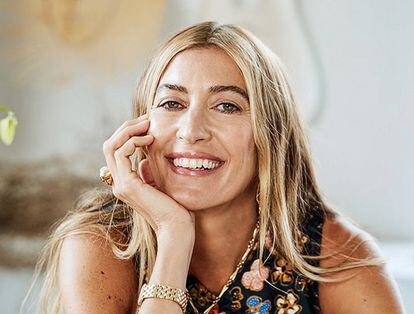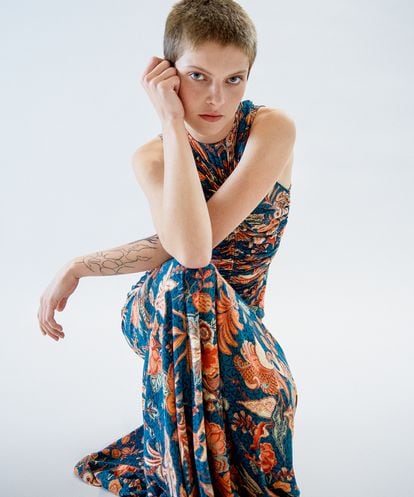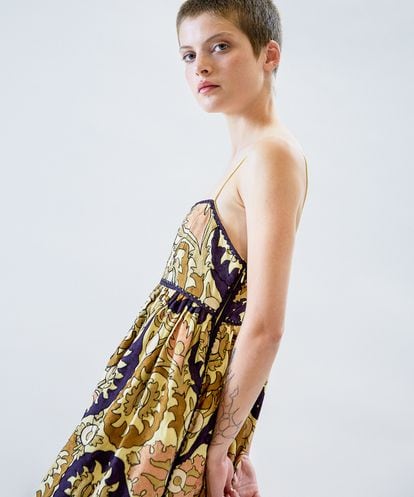Ulla Johnson, the New York designer who creates ‘future relics’ | Culture

Ulla Johnson had no intention of going into fashion (she studied gender studies and psychology), but after graduating in 2000 she decided to use the artisanal fabric she had collected on her archaeology trips with her parents. It’s still her passion, 20 years after she started, and with a brand with over 200 retail points in the world. “The basis of our business is the communities of artisans, with whom we work to develop our collections; we usually work with women from Peru, Uruguay, Pakistan, India or Kenya. During the pandemic, which made it difficult for us to access certain countries, we found embroiderers and crochet artisans in Brooklyn, and we added them to the rest of the suppliers,” she explains.
Johnson was a believer in sustainability and craftsmanship (not only environmental but also human rights) even before anyone else. When, at the beginning of the century, Barneys took an interest in her collection and began to sell it, getting other temples of luxury — both physical and digital — to notice her, the designer decided to slow down the pace of her expansion in order to become a mother and, during that break, think about where she wanted to take her business.

She didn’t participate in fashion shows until 2014. This was when her brand had already become a global success, and she could afford to do so. “Now there’s more interest in handmade things and it’s wonderful, but for me fashion only makes sense when it has an emotional value for the person who wears it and, as far as I am concerned, as a designer, I can provide that if the material is handmade and if in the process I can add value and support the communities that make it,” she says. That is why, as she found artisans from different continents (she usually travels to meet them and work with them twice a year), she decided to raise her prices, which now range between $500 and $1,000: “It’s what’s fair if you want to pay the artisans well,” she explains. A few months ago, she launched a service on her website where her customers can sell used pieces from previous collections at lower prices, “and we have a customer service that helps clients find specific garments.”
In fact, Ulla Johnson likes to say that she designs “future heirlooms,” that is, emotionally charged garments meant to be passed on to future generations. Ulla Johnson does not want external investors or conglomerates to become involved in her business. Instead, she prefers to grow at a slower pace. And, at a time when other American brands are looking for a place in Paris or Milan, to do everything in New York, from her studio in Soho to her presentations, usually carried out in unusual sites, from Roosevelt Island to the Brooklyn Museum: “I don’t know what will happen in the future,” she explains, “but I was born here, and I built my business here. New York inspires me and I believe the city is a big part of what I do. Never say never, but for now I don’t see myself expanding or moving my business.”

This does not mean, however, that the brand has no medium-term plan. In the last five years, Ulla Johnson has expanded her business line “due to the demand of my customers,” she says. She no longer only creates the bohemian style garments that made Ulla Johnson famous. Now, she also designs shoes, bags and jewelry, as well as party dresses. “Our buyers asked for it, because the desire to dress up has returned — although, actually, what is really happening is that there is no longer a sense of being overdressed or underdressed. I myself am surprised when I decide to dress up to spend the day with my family,” she reflects.

That sums up Ulla Johnson’s creative process, a mix between what her customers want and what she herself would wear (in fact, her website includes a section dedicated to her wardrobe): “I wear my clothes every day and I design thinking about how this or that garment makes me feel. It’s my way of being honest with my clients, believing that if it’s easy for me to wear, it will also be for them,” she explains. “Everything I do, from the shape to the print, the zippers, or the pockets (I even put pockets in the party pieces that are shown on the runway) is designed to make you feel good and comfortable. I don’t care about what looks good but isn’t real. I don’t want to overwhelm the consumer.”
Sign up for our weekly newsletter to get more English-language news coverage from EL PAÍS USA Edition